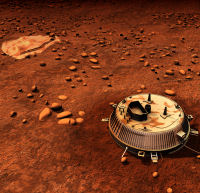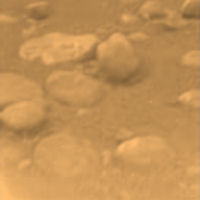ESA and NASA celebrate the fifth anniversary of Titan landing
14 January 2010
Exactly five years ago today the European Space Agency's (ESA) Huygens Probe made history when it landed on Titan, the largest moon in the Saturnian system. The touchdown on the surface of Titan marked the first, and so far only, landing of a man-made probe in the outer Solar System. Today many of the scientists and engineers that worked on the mission will celebrate this anniversary in the science museum Cosmocaixa in Barcelona, Spain. They will share their memories with the public and reveal future projects, "much work remains to be done", says ESA's Huygens Project Scientist Jean-Pierre Lebreton, "Titan has many different environments to explore further with in situ probes".
 |
|
The Huygens probe Credit: ESA |
"I remember it very vividly, it was a very intense moment", says Álvaro Giménez Cañete, ESA Science Policy Coordinator and Director of the Spanish Centre for Astrobiology. "We didn't even know whether Huygens would survive the impact. We didn't know then if the touchdown would be on a solid surface or in a sea. Then, when the first pictures arrived, I was struck by the apparently strong similarities with Mars or even the Earth: Titan had a ground, rocks.... Of course we soon learnt that it is very different from Earth, a fascinating cold world in which methane plays the role of water on Earth".
Five years ago Gimenez was in Darmstadt, Germany, witnessing the event from ESA's European Space Operations Centre (ESOC) and is now participating in the celebration to mark the fifth anniversary of this remarkable event at the Huygens Legacy and Future Titan Exploration conference, which will run for three days from 13 - 15 January 2010. The conference will cover a broad range of topics including science results from the Huygens in situ exploration of Titan, results from studies of this moon using remote sensing from instruments on the Cassini Orbiter combined with Huygens data, and the role of ground-based observations, laboratory data and modelling in interpreting the observations of Titan from space.
 |
|
Titan's surface Credit: ESA/NASA/JPL/University of Arizona |
Due to a smooth landing on Titan the Huygens probe survived for longer than anticipated and only ceased to operate once the onboard batteries had no power remaining. The Cassini Equinox Mission, which commenced 1 July 2008, is continuing the tour of the Saturnian system, including further flybys of Titan. In addition the Cassini Equinox Mission will monitor the seasonal effects on Titan and Saturn "We expect seasonal effects on Titan too", says Dennis Matson, Senior Research Scientist Titan and Saturn System Mission (TSSM) Jet Propulsion Laboratory (Caltech). "Will the size and number of the lakes in the South grow as winter comes? Shall we see the northern lakes and seas diminish or dry up as summer progresses?".
"The amazing discoveries have redefined our concept of the whole system. We are seeing many features and processes for the first time. Some of them are beautiful, some astound us, and others tax our abilities of explanation", write both Matson and Lebreton.
